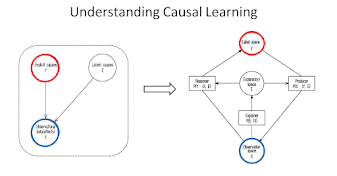Understanding Causal Learning
.png)
Traditional causal model: It represents a traditional causal model with two main components: Observational Data (X) : These are the effects or outcomes that we can measure or observe directly. Explicit Causes (Y) : These are the known factors that we believe have a direct impact on the observational data. Latent Causes (E) : These are hidden or unknown factors that may also influence the observational data but are not directly observed. Structured causal learning mode: it is a complex and structured causal learning model, often used in machine learning, with several components: Explainer (P(E | X)) : This is a model that tries to uncover the latent causes (E) given the observational data (X). It's like looking for hidden factors that explain the observed outcomes. Reasoner (P(Y | X, E)) : Given the observational data and the explanations from the Explainer, the Reasoner tries to infer the explicit causes (Y). It's about understanding what the known factors might be given the da...
.png)